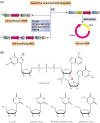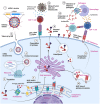mRNA vaccines in the prevention and treatment of diseases
- PMID: 36033422
- PMCID: PMC9409637
- DOI: 10.1002/mco2.167
mRNA vaccines in the prevention and treatment of diseases
Abstract
Messenger ribonucleic acid (mRNA) vaccines made their successful public debut in the effort against the COVID-19 outbreak starting in late 2019, although the history of mRNA vaccines can be traced back decades. This review provides an overview to discuss the historical course and present situation of mRNA vaccine development in addition to some basic concepts that underly mRNA vaccines. We discuss the general preparation and manufacturing of mRNA vaccines and also discuss the scientific advances in the in vivo delivery system and evaluate popular approaches (i.e., lipid nanoparticle and protamine) in detail. Next, we highlight the clinical value of mRNA vaccines as potent candidates for therapeutic treatment and discuss clinical progress in the treatment of cancer and coronavirus disease 2019. Data suggest that mRNA vaccines, with several prominent advantages, have achieved encouraging results and increasing attention due to tremendous potential in disease management. Finally, we suggest some potential directions worthy of further investigation and optimization. In addition to basic research, studies that help to facilitate storage and transportation will be indispensable for practical applications.
Keywords: cancer; infectious diseases; lipid nanoparticles; mRNA delivery; mRNA vaccine.
© 2022 The Authors. MedComm published by Sichuan International Medical Exchange & Promotion Association (SCIMEA) and John Wiley & Sons Australia, Ltd.
Conflict of interest statement
The authors declare there is no conflict of interest.
Figures





Similar articles
-
The Rapid Development and Early Success of Covid 19 Vaccines Have Raised Hopes for Accelerating the Cancer Treatment Mechanism.Arch Razi Inst. 2021 Mar;76(1):1-6. doi: 10.22092/ari.2021.353761.1612. Epub 2021 Mar 1. Arch Razi Inst. 2021. PMID: 33818952 Free PMC article.
-
mRNA as a Transformative Technology for Vaccine Development to Control Infectious Diseases.Mol Ther. 2019 Apr 10;27(4):757-772. doi: 10.1016/j.ymthe.2019.01.020. Epub 2019 Feb 7. Mol Ther. 2019. PMID: 30803823 Free PMC article. Review.
-
The clinical progress and challenges of mRNA vaccines.Wiley Interdiscip Rev Nanomed Nanobiotechnol. 2023 Sep-Oct;15(5):e1894. doi: 10.1002/wnan.1894. Epub 2023 Apr 24. Wiley Interdiscip Rev Nanomed Nanobiotechnol. 2023. PMID: 37096256 Review.
-
Lipid nanoparticles for mRNA delivery.Nat Rev Mater. 2021;6(12):1078-1094. doi: 10.1038/s41578-021-00358-0. Epub 2021 Aug 10. Nat Rev Mater. 2021. PMID: 34394960 Free PMC article. Review.
-
COVID-19 mRNA vaccines: Platforms and current developments.Mol Ther. 2022 May 4;30(5):1850-1868. doi: 10.1016/j.ymthe.2022.02.016. Epub 2022 Feb 19. Mol Ther. 2022. PMID: 35189345 Free PMC article. Review.
Cited by
-
Strategies to reduce the risks of mRNA drug and vaccine toxicity.Nat Rev Drug Discov. 2024 Apr;23(4):281-300. doi: 10.1038/s41573-023-00859-3. Epub 2024 Jan 23. Nat Rev Drug Discov. 2024. PMID: 38263456 Review.
-
Humoral Response Following 3 Doses of mRNA COVID-19 Vaccines in Patients With Non-Dialysis-Dependent CKD: An Observational Study.Can J Kidney Health Dis. 2024 Jan 29;11:20543581231224127. doi: 10.1177/20543581231224127. eCollection 2024. Can J Kidney Health Dis. 2024. PMID: 38292817 Free PMC article.
-
The Dawning of a New Enterprise: RNA Therapeutics for the Skin.J Dermatol Skin Sci. 2023;5(1):4-13. doi: 10.29245/2767-5092/2023/1.1168. Epub 2023 Mar 9. J Dermatol Skin Sci. 2023. PMID: 38435714 Free PMC article.
-
Current Status and Challenges of Vaccination Therapy for Glioblastoma.Mol Cancer Ther. 2023 Apr 3;22(4):435-446. doi: 10.1158/1535-7163.MCT-22-0503. Mol Cancer Ther. 2023. PMID: 36779991 Free PMC article.
-
The transformative potential of mRNA vaccines for glioblastoma and human cancer: technological advances and translation to clinical trials.Front Oncol. 2024 Sep 27;14:1454370. doi: 10.3389/fonc.2024.1454370. eCollection 2024. Front Oncol. 2024. PMID: 39399167 Free PMC article. Review.
References
-
- Kardani K, Bolhassani AJC. Vaccine development against SARS‐CoV‐2: from virology to vaccine clinical trials. Coronaviruses. 2021;2(2):159‐171.
-
- Pardi N, Hogan MJ, Weissman D. Recent advances in mRNA vaccine technology. Curr Opin Immunol. 2020;65:14‐20. - PubMed
Publication types
LinkOut - more resources
Full Text Sources
Other Literature Sources
